Refine search
No keyword found to refine search
keywords EN
Places
Names
456 documents found
| 1 | 8 |
Documents per page :

Death of Alain Delon
Michael Bunel / Le Pictorium
LePictorium_0296623.jpg
In front of the entrance to Alain Delon's estate (La Brûlerie), dozens of flowers have been laid by admirers since the actor's death on August 18, 2024. August 20, 2024. Douchy Montcorbon (Gatinais), France.

Death of Alain Delon
Michael Bunel / Le Pictorium
LePictorium_0296624.jpg
In front of the entrance to Alain Delon's estate (La Brûlerie), dozens of flowers have been laid by admirers since the actor's death on August 18, 2024. August 20, 2024. Douchy Montcorbon (Gatinais), France.

Death of Alain Delon
Michael Bunel / Le Pictorium
LePictorium_0296625.jpg
In front of the entrance to Alain Delon's estate (La Brûlerie), dozens of flowers have been laid by admirers since the actor's death on August 18, 2024. August 20, 2024. Douchy Montcorbon (Gatinais), France.

Death of Alain Delon
Michael Bunel / Le Pictorium
LePictorium_0296626.jpg
In front of the entrance to Alain Delon's estate (La Brûlerie), dozens of flowers have been laid by admirers since the actor's death on August 18, 2024. August 20, 2024. Douchy Montcorbon (Gatinais), France.

Death of Alain Delon
Michael Bunel / Le Pictorium
LePictorium_0296627.jpg
In front of the entrance to Alain Delon's estate (La Brûlerie), dozens of flowers have been laid by admirers since the actor's death on August 18, 2024. August 20, 2024. Douchy Montcorbon (Gatinais), France.

Death of Alain Delon
Michael Bunel / Le Pictorium
LePictorium_0296628.jpg
In front of the entrance to Alain Delon's estate (La Brûlerie), dozens of flowers have been laid by admirers since the actor's death on August 18, 2024. August 20, 2024. Douchy Montcorbon (Gatinais), France.

Death of Alain Delon
Michael Bunel / Le Pictorium
LePictorium_0296629.jpg
In front of the entrance to Alain Delon's estate (La Brûlerie), dozens of flowers have been laid by admirers since the actor's death on August 18, 2024. August 20, 2024. Douchy Montcorbon (Gatinais), France.

Death of Alain Delon
Michael Bunel / Le Pictorium
LePictorium_0296630.jpg
In front of the entrance to Alain Delon's estate (La Brûlerie), dozens of flowers have been laid by admirers since the actor's death on August 18, 2024. August 20, 2024. Douchy Montcorbon (Gatinais), France.

Death of Alain Delon
Michael Bunel / Le Pictorium
LePictorium_0296631.jpg
In front of the entrance to Alain Delon's estate (La Brûlerie), dozens of flowers have been laid by admirers since the actor's death on August 18, 2024. August 20, 2024. Douchy Montcorbon (Gatinais), France.

Death of Alain Delon
Michael Bunel / Le Pictorium
LePictorium_0296632.jpg
In front of the entrance to Alain Delon's estate (La Brûlerie), dozens of flowers have been laid by admirers since the actor's death on August 18, 2024. August 20, 2024. Douchy Montcorbon (Gatinais), France.

Death of Alain Delon
Michael Bunel / Le Pictorium
LePictorium_0296633.jpg
In front of the entrance to Alain Delon's estate (La Brûlerie), dozens of flowers have been laid by admirers since the actor's death on August 18, 2024. August 20, 2024. Douchy Montcorbon (Gatinais), France.

Death of Alain Delon
Michael Bunel / Le Pictorium
LePictorium_0296634.jpg
In front of the entrance to Alain Delon's estate (La Brûlerie), dozens of flowers have been laid by admirers since the actor's death on August 18, 2024. August 20, 2024. Douchy Montcorbon (Gatinais), France.

Death of Alain Delon
Michael Bunel / Le Pictorium
LePictorium_0296635.jpg
In front of the entrance to Alain Delon's estate (La Brûlerie), dozens of flowers have been laid by admirers since the actor's death on August 18, 2024. August 20, 2024. Douchy Montcorbon (Gatinais), France.

Death of Alain Delon
Michael Bunel / Le Pictorium
LePictorium_0296636.jpg
In front of the entrance to Alain Delon's estate (La Brûlerie), dozens of flowers have been laid by admirers since the actor's death on August 18, 2024. August 20, 2024. Douchy Montcorbon (Gatinais), France.

Death of Alain Delon
Michael Bunel / Le Pictorium
LePictorium_0296637.jpg
In front of the entrance to Alain Delon's estate (La Brûlerie), dozens of flowers have been laid by admirers since the actor's death on August 18, 2024. August 20, 2024. Douchy Montcorbon (Gatinais), France.

Illustrative pictures of Lithuania
Jan Schmidt-Whitley/Le Pictorium
LePictorium_0289236.jpg
Gate of Dawn (Aušros vartai in Lithuanian) is a Catholic pilgrimage site located in the historic centre of Vilnius. This place of Marian pilgrimage is very important in the history of Polish Catholicism, at a time when Vilnius was a city populated mainly by Poles. Today, the Gate of Dawn, with its icon of the Virgin Mary, is visited by Vilnius residents and tourists alike.
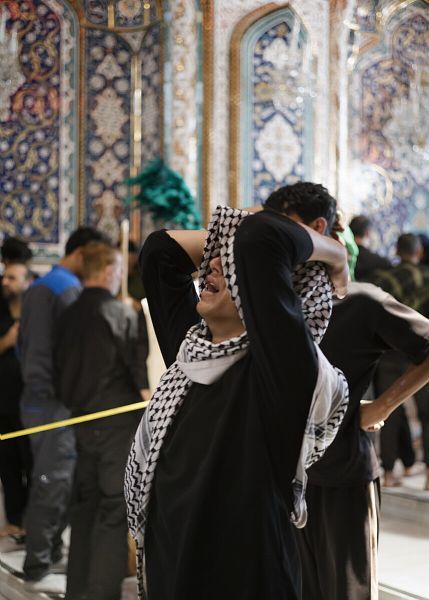
Arbaeen: a shared grief
Gabriel Gauffre / Le Pictorium
LePictorium_0283164.jpg
Worshippers inside the Shrine of Imam Hussein.
Among Shiite Muslims, Arbaeen commemorates the end of the mourning period for Imam Hussein, an important figure who died in 680 at the battle of Karbala, located in present-day Iraq. As one of the most important dates for this community, Shiites from all over the world come to pay their respects at the mausoleum erected on the site of his death. In 2023, 20 million pilgrims, mainly from Iran, but also from Afghanistan and Pakistan, made the journey to this holy city two hours' drive south of Baghdad. Largely repressed under Saddam Hussein, this pilgrimage has grown to become the largest gathering of human beings in the world.
Among Shiite Muslims, Arbaeen commemorates the end of the mourning period for Imam Hussein, an important figure who died in 680 at the battle of Karbala, located in present-day Iraq. As one of the most important dates for this community, Shiites from all over the world come to pay their respects at the mausoleum erected on the site of his death. In 2023, 20 million pilgrims, mainly from Iran, but also from Afghanistan and Pakistan, made the journey to this holy city two hours' drive south of Baghdad. Largely repressed under Saddam Hussein, this pilgrimage has grown to become the largest gathering of human beings in the world.
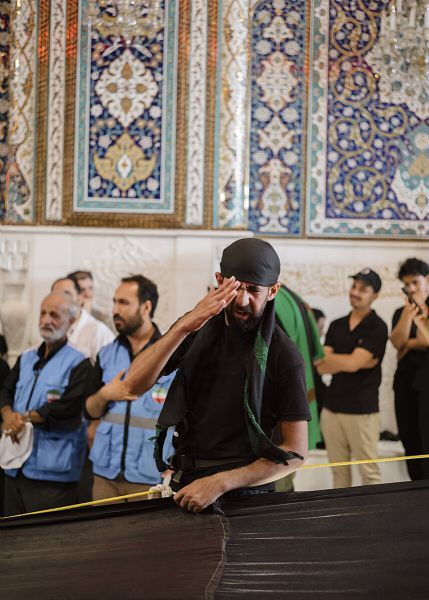
Arbaeen: a shared grief
Gabriel Gauffre / Le Pictorium
LePictorium_0283165.jpg
Worshippers inside the Shrine of Imam Hussein.
Among Shiite Muslims, Arbaeen commemorates the end of the mourning period for Imam Hussein, an important figure who died in 680 at the battle of Karbala, located in present-day Iraq. As one of the most important dates for this community, Shiites from all over the world come to pay their respects at the mausoleum erected on the site of his death. In 2023, 20 million pilgrims, mainly from Iran, but also from Afghanistan and Pakistan, made the journey to this holy city two hours' drive south of Baghdad. Largely repressed under Saddam Hussein, this pilgrimage has grown to become the largest gathering of human beings in the world.
Among Shiite Muslims, Arbaeen commemorates the end of the mourning period for Imam Hussein, an important figure who died in 680 at the battle of Karbala, located in present-day Iraq. As one of the most important dates for this community, Shiites from all over the world come to pay their respects at the mausoleum erected on the site of his death. In 2023, 20 million pilgrims, mainly from Iran, but also from Afghanistan and Pakistan, made the journey to this holy city two hours' drive south of Baghdad. Largely repressed under Saddam Hussein, this pilgrimage has grown to become the largest gathering of human beings in the world.
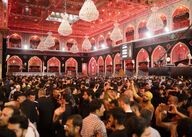
Arbaeen: a shared grief
Gabriel Gauffre / Le Pictorium
LePictorium_0283166.jpg
Worshippers inside the Shrine of Imam Hussein.
Among Shiite Muslims, Arbaeen commemorates the end of the mourning period for Imam Hussein, an important figure who died in 680 at the battle of Karbala, located in present-day Iraq. As one of the most important dates for this community, Shiites from all over the world come to pay their respects at the mausoleum erected on the site of his death. In 2023, 20 million pilgrims, mainly from Iran, but also from Afghanistan and Pakistan, made the journey to this holy city two hours' drive south of Baghdad. Largely repressed under Saddam Hussein, this pilgrimage has grown to become the largest gathering of human beings in the world.
Among Shiite Muslims, Arbaeen commemorates the end of the mourning period for Imam Hussein, an important figure who died in 680 at the battle of Karbala, located in present-day Iraq. As one of the most important dates for this community, Shiites from all over the world come to pay their respects at the mausoleum erected on the site of his death. In 2023, 20 million pilgrims, mainly from Iran, but also from Afghanistan and Pakistan, made the journey to this holy city two hours' drive south of Baghdad. Largely repressed under Saddam Hussein, this pilgrimage has grown to become the largest gathering of human beings in the world.
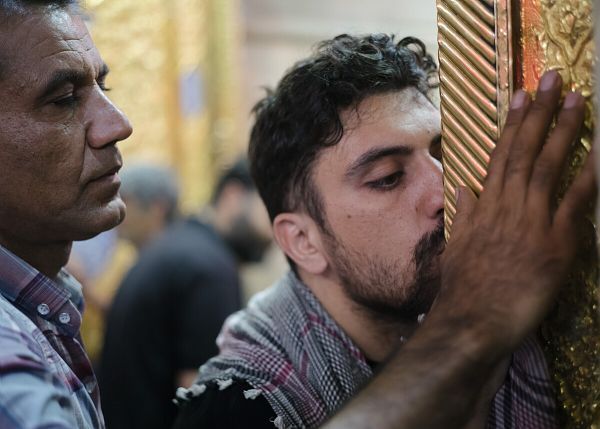
Arbaeen: a shared grief
Gabriel Gauffre / Le Pictorium
LePictorium_0283167.jpg
Worshippers inside the Shrine of Imam Hussein.
Among Shiite Muslims, Arbaeen commemorates the end of the mourning period for Imam Hussein, an important figure who died in 680 at the battle of Karbala, located in present-day Iraq. As one of the most important dates for this community, Shiites from all over the world come to pay their respects at the mausoleum erected on the site of his death. In 2023, 20 million pilgrims, mainly from Iran, but also from Afghanistan and Pakistan, made the journey to this holy city two hours' drive south of Baghdad. Largely repressed under Saddam Hussein, this pilgrimage has grown to become the largest gathering of human beings in the world.
Among Shiite Muslims, Arbaeen commemorates the end of the mourning period for Imam Hussein, an important figure who died in 680 at the battle of Karbala, located in present-day Iraq. As one of the most important dates for this community, Shiites from all over the world come to pay their respects at the mausoleum erected on the site of his death. In 2023, 20 million pilgrims, mainly from Iran, but also from Afghanistan and Pakistan, made the journey to this holy city two hours' drive south of Baghdad. Largely repressed under Saddam Hussein, this pilgrimage has grown to become the largest gathering of human beings in the world.
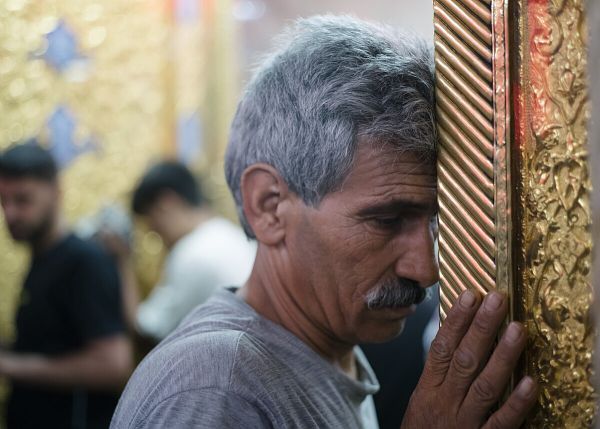
Arbaeen: a shared grief
Gabriel Gauffre / Le Pictorium
LePictorium_0283168.jpg
Worshippers inside the Shrine of Imam Hussein.
Among Shiite Muslims, Arbaeen commemorates the end of the mourning period for Imam Hussein, an important figure who died in 680 at the battle of Karbala, located in present-day Iraq. As one of the most important dates for this community, Shiites from all over the world come to pay their respects at the mausoleum erected on the site of his death. In 2023, 20 million pilgrims, mainly from Iran, but also from Afghanistan and Pakistan, made the journey to this holy city two hours' drive south of Baghdad. Largely repressed under Saddam Hussein, this pilgrimage has grown to become the largest gathering of human beings in the world.
Among Shiite Muslims, Arbaeen commemorates the end of the mourning period for Imam Hussein, an important figure who died in 680 at the battle of Karbala, located in present-day Iraq. As one of the most important dates for this community, Shiites from all over the world come to pay their respects at the mausoleum erected on the site of his death. In 2023, 20 million pilgrims, mainly from Iran, but also from Afghanistan and Pakistan, made the journey to this holy city two hours' drive south of Baghdad. Largely repressed under Saddam Hussein, this pilgrimage has grown to become the largest gathering of human beings in the world.

Arbaeen: a shared grief
Gabriel Gauffre / Le Pictorium
LePictorium_0283169.jpg
Worshippers inside the Shrine of Imam Hussein.
Among Shiite Muslims, Arbaeen commemorates the end of the mourning period for Imam Hussein, an important figure who died in 680 at the battle of Karbala, located in present-day Iraq. As one of the most important dates for this community, Shiites from all over the world come to pay their respects at the mausoleum erected on the site of his death. In 2023, 20 million pilgrims, mainly from Iran, but also from Afghanistan and Pakistan, made the journey to this holy city two hours' drive south of Baghdad. Largely repressed under Saddam Hussein, this pilgrimage has grown to become the largest gathering of human beings in the world.
Among Shiite Muslims, Arbaeen commemorates the end of the mourning period for Imam Hussein, an important figure who died in 680 at the battle of Karbala, located in present-day Iraq. As one of the most important dates for this community, Shiites from all over the world come to pay their respects at the mausoleum erected on the site of his death. In 2023, 20 million pilgrims, mainly from Iran, but also from Afghanistan and Pakistan, made the journey to this holy city two hours' drive south of Baghdad. Largely repressed under Saddam Hussein, this pilgrimage has grown to become the largest gathering of human beings in the world.
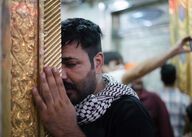
Arbaeen: a shared grief
Gabriel Gauffre / Le Pictorium
LePictorium_0283170.jpg
Worshippers inside the Shrine of Imam Hussein.
Among Shiite Muslims, Arbaeen commemorates the end of the mourning period for Imam Hussein, an important figure who died in 680 at the battle of Karbala, located in present-day Iraq. As one of the most important dates for this community, Shiites from all over the world come to pay their respects at the mausoleum erected on the site of his death. In 2023, 20 million pilgrims, mainly from Iran, but also from Afghanistan and Pakistan, made the journey to this holy city two hours' drive south of Baghdad. Largely repressed under Saddam Hussein, this pilgrimage has grown to become the largest gathering of human beings in the world.
Among Shiite Muslims, Arbaeen commemorates the end of the mourning period for Imam Hussein, an important figure who died in 680 at the battle of Karbala, located in present-day Iraq. As one of the most important dates for this community, Shiites from all over the world come to pay their respects at the mausoleum erected on the site of his death. In 2023, 20 million pilgrims, mainly from Iran, but also from Afghanistan and Pakistan, made the journey to this holy city two hours' drive south of Baghdad. Largely repressed under Saddam Hussein, this pilgrimage has grown to become the largest gathering of human beings in the world.

Arbaeen: a shared grief
Gabriel Gauffre / Le Pictorium
LePictorium_0283171.jpg
Worshippers inside the Shrine of Imam Hussein.
Among Shiite Muslims, Arbaeen commemorates the end of the mourning period for Imam Hussein, an important figure who died in 680 at the battle of Karbala, located in present-day Iraq. As one of the most important dates for this community, Shiites from all over the world come to pay their respects at the mausoleum erected on the site of his death. In 2023, 20 million pilgrims, mainly from Iran, but also from Afghanistan and Pakistan, made the journey to this holy city two hours' drive south of Baghdad. Largely repressed under Saddam Hussein, this pilgrimage has grown to become the largest gathering of human beings in the world.
Among Shiite Muslims, Arbaeen commemorates the end of the mourning period for Imam Hussein, an important figure who died in 680 at the battle of Karbala, located in present-day Iraq. As one of the most important dates for this community, Shiites from all over the world come to pay their respects at the mausoleum erected on the site of his death. In 2023, 20 million pilgrims, mainly from Iran, but also from Afghanistan and Pakistan, made the journey to this holy city two hours' drive south of Baghdad. Largely repressed under Saddam Hussein, this pilgrimage has grown to become the largest gathering of human beings in the world.
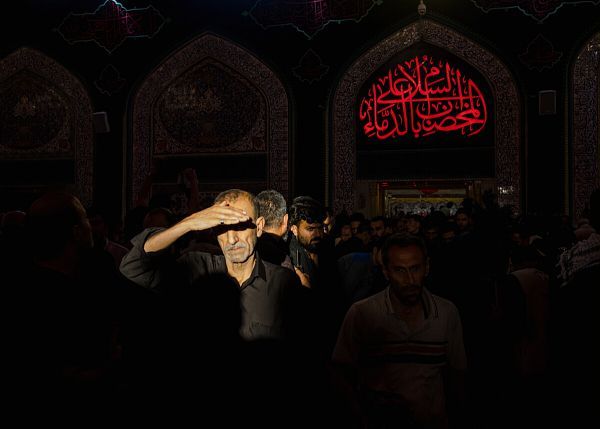
Arbaeen: a shared grief
Gabriel Gauffre / Le Pictorium
LePictorium_0283172.jpg
Worshippers inside the Shrine of Imam Hussein.
Among Shiite Muslims, Arbaeen commemorates the end of the mourning period for Imam Hussein, an important figure who died in 680 at the battle of Karbala, located in present-day Iraq. As one of the most important dates for this community, Shiites from all over the world come to pay their respects at the mausoleum erected on the site of his death. In 2023, 20 million pilgrims, mainly from Iran, but also from Afghanistan and Pakistan, made the journey to this holy city two hours' drive south of Baghdad. Largely repressed under Saddam Hussein, this pilgrimage has grown to become the largest gathering of human beings in the world.
Among Shiite Muslims, Arbaeen commemorates the end of the mourning period for Imam Hussein, an important figure who died in 680 at the battle of Karbala, located in present-day Iraq. As one of the most important dates for this community, Shiites from all over the world come to pay their respects at the mausoleum erected on the site of his death. In 2023, 20 million pilgrims, mainly from Iran, but also from Afghanistan and Pakistan, made the journey to this holy city two hours' drive south of Baghdad. Largely repressed under Saddam Hussein, this pilgrimage has grown to become the largest gathering of human beings in the world.

Arbaeen: a shared grief
Gabriel Gauffre / Le Pictorium
LePictorium_0283173.jpg
A law enforcement volunteer inside Imam Hussein's mausoleum.
Among Shiite Muslims, Arbaeen commemorates the end of the mourning period for Imam Hussein, an important figure who died in 680 at the battle of Karbala, located in present-day Iraq. As one of the most important dates for this community, Shiites from all over the world come to pay their respects at the mausoleum erected on the site of his death. In 2023, 20 million pilgrims, mainly from Iran, but also from Afghanistan and Pakistan, made the journey to this holy city two hours' drive south of Baghdad. Largely repressed under Saddam Hussein, this pilgrimage has grown to become the largest gathering of human beings in the world.
Among Shiite Muslims, Arbaeen commemorates the end of the mourning period for Imam Hussein, an important figure who died in 680 at the battle of Karbala, located in present-day Iraq. As one of the most important dates for this community, Shiites from all over the world come to pay their respects at the mausoleum erected on the site of his death. In 2023, 20 million pilgrims, mainly from Iran, but also from Afghanistan and Pakistan, made the journey to this holy city two hours' drive south of Baghdad. Largely repressed under Saddam Hussein, this pilgrimage has grown to become the largest gathering of human beings in the world.
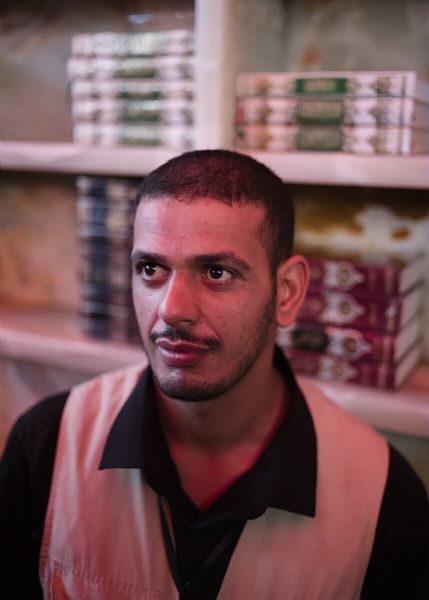
Arbaeen: a shared grief
Gabriel Gauffre / Le Pictorium
LePictorium_0283174.jpg
A law enforcement volunteer inside Imam Hussein's mausoleum.
Among Shiite Muslims, Arbaeen commemorates the end of the mourning period for Imam Hussein, an important figure who died in 680 at the battle of Karbala, located in present-day Iraq. As one of the most important dates for this community, Shiites from all over the world come to pay their respects at the mausoleum erected on the site of his death. In 2023, 20 million pilgrims, mainly from Iran, but also from Afghanistan and Pakistan, made the journey to this holy city two hours' drive south of Baghdad. Largely repressed under Saddam Hussein, this pilgrimage has grown to become the largest gathering of human beings in the world.
Among Shiite Muslims, Arbaeen commemorates the end of the mourning period for Imam Hussein, an important figure who died in 680 at the battle of Karbala, located in present-day Iraq. As one of the most important dates for this community, Shiites from all over the world come to pay their respects at the mausoleum erected on the site of his death. In 2023, 20 million pilgrims, mainly from Iran, but also from Afghanistan and Pakistan, made the journey to this holy city two hours' drive south of Baghdad. Largely repressed under Saddam Hussein, this pilgrimage has grown to become the largest gathering of human beings in the world.
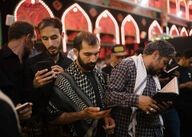
Arbaeen: a shared grief
Gabriel Gauffre / Le Pictorium
LePictorium_0283175.jpg
Worshippers inside the Shrine of Imam Hussein.
Among Shiite Muslims, Arbaeen commemorates the end of the mourning period for Imam Hussein, an important figure who died in 680 at the battle of Karbala, located in present-day Iraq. As one of the most important dates for this community, Shiites from all over the world come to pay their respects at the mausoleum erected on the site of his death. In 2023, 20 million pilgrims, mainly from Iran, but also from Afghanistan and Pakistan, made the journey to this holy city two hours' drive south of Baghdad. Largely repressed under Saddam Hussein, this pilgrimage has grown to become the largest gathering of human beings in the world.
Among Shiite Muslims, Arbaeen commemorates the end of the mourning period for Imam Hussein, an important figure who died in 680 at the battle of Karbala, located in present-day Iraq. As one of the most important dates for this community, Shiites from all over the world come to pay their respects at the mausoleum erected on the site of his death. In 2023, 20 million pilgrims, mainly from Iran, but also from Afghanistan and Pakistan, made the journey to this holy city two hours' drive south of Baghdad. Largely repressed under Saddam Hussein, this pilgrimage has grown to become the largest gathering of human beings in the world.

Arbaeen: a shared grief
Gabriel Gauffre / Le Pictorium
LePictorium_0283176.jpg
Worshippers inside the Shrine of Imam Hussein.
Among Shiite Muslims, Arbaeen commemorates the end of the mourning period for Imam Hussein, an important figure who died in 680 at the battle of Karbala, located in present-day Iraq. As one of the most important dates for this community, Shiites from all over the world come to pay their respects at the mausoleum erected on the site of his death. In 2023, 20 million pilgrims, mainly from Iran, but also from Afghanistan and Pakistan, made the journey to this holy city two hours' drive south of Baghdad. Largely repressed under Saddam Hussein, this pilgrimage has grown to become the largest gathering of human beings in the world.
Among Shiite Muslims, Arbaeen commemorates the end of the mourning period for Imam Hussein, an important figure who died in 680 at the battle of Karbala, located in present-day Iraq. As one of the most important dates for this community, Shiites from all over the world come to pay their respects at the mausoleum erected on the site of his death. In 2023, 20 million pilgrims, mainly from Iran, but also from Afghanistan and Pakistan, made the journey to this holy city two hours' drive south of Baghdad. Largely repressed under Saddam Hussein, this pilgrimage has grown to become the largest gathering of human beings in the world.
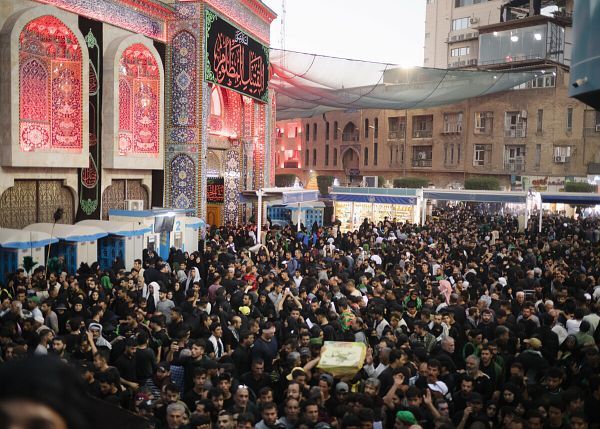
Arbaeen: a shared grief
Gabriel Gauffre / Le Pictorium
LePictorium_0283177.jpg
Worshippers inside the Shrine of Imam Hussein.
Among Shiite Muslims, Arbaeen commemorates the end of the mourning period for Imam Hussein, an important figure who died in 680 at the battle of Karbala, located in present-day Iraq. As one of the most important dates for this community, Shiites from all over the world come to pay their respects at the mausoleum erected on the site of his death. In 2023, 20 million pilgrims, mainly from Iran, but also from Afghanistan and Pakistan, made the journey to this holy city two hours' drive south of Baghdad. Largely repressed under Saddam Hussein, this pilgrimage has grown to become the largest gathering of human beings in the world.
Among Shiite Muslims, Arbaeen commemorates the end of the mourning period for Imam Hussein, an important figure who died in 680 at the battle of Karbala, located in present-day Iraq. As one of the most important dates for this community, Shiites from all over the world come to pay their respects at the mausoleum erected on the site of his death. In 2023, 20 million pilgrims, mainly from Iran, but also from Afghanistan and Pakistan, made the journey to this holy city two hours' drive south of Baghdad. Largely repressed under Saddam Hussein, this pilgrimage has grown to become the largest gathering of human beings in the world.
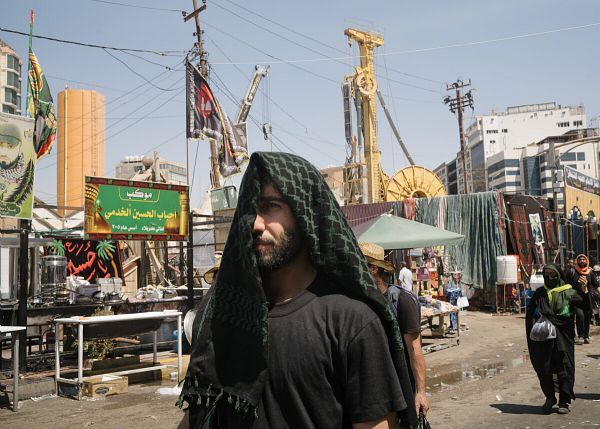
Arbaeen: a shared grief
Gabriel Gauffre / Le Pictorium
LePictorium_0283178.jpg
Among Shiite Muslims, Arbaeen commemorates the end of the mourning period for Imam Hussein, an important figure who died in 680 at the battle of Karbala, located in present-day Iraq. As one of the most important dates for this community, Shiites from all over the world come to pay their respects at the mausoleum erected on the site of his death. In 2023, 20 million pilgrims, mainly from Iran, but also from Afghanistan and Pakistan, made the journey to this holy city two hours' drive south of Baghdad. Largely repressed under Saddam Hussein, this pilgrimage has grown to become the largest gathering of human beings in the world.
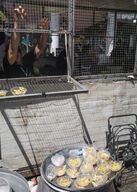
Arbaeen: a shared grief
Gabriel Gauffre / Le Pictorium
LePictorium_0283179.jpg
Among Shiite Muslims, Arbaeen commemorates the end of the mourning period for Imam Hussein, an important figure who died in 680 at the battle of Karbala, located in present-day Iraq. As one of the most important dates for this community, Shiites from all over the world come to pay their respects at the mausoleum erected on the site of his death. In 2023, 20 million pilgrims, mainly from Iran, but also from Afghanistan and Pakistan, made the journey to this holy city two hours' drive south of Baghdad. Largely repressed under Saddam Hussein, this pilgrimage has grown to become the largest gathering of human beings in the world.
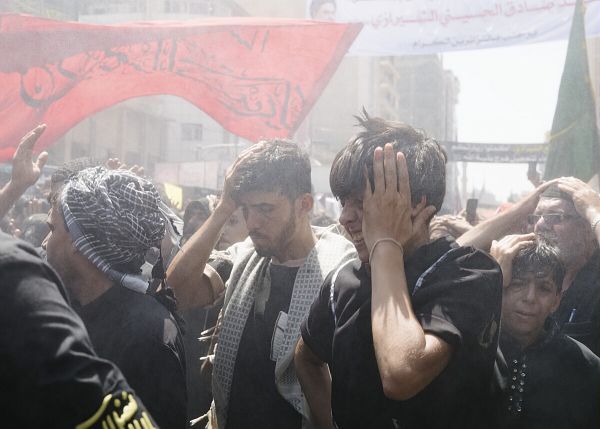
Arbaeen: a shared grief
Gabriel Gauffre / Le Pictorium
LePictorium_0283180.jpg
Among Shiite Muslims, Arbaeen commemorates the end of the mourning period for Imam Hussein, an important figure who died in 680 at the battle of Karbala, located in present-day Iraq. As one of the most important dates for this community, Shiites from all over the world come to pay their respects at the mausoleum erected on the site of his death. In 2023, 20 million pilgrims, mainly from Iran, but also from Afghanistan and Pakistan, made the journey to this holy city two hours' drive south of Baghdad. Largely repressed under Saddam Hussein, this pilgrimage has grown to become the largest gathering of human beings in the world.
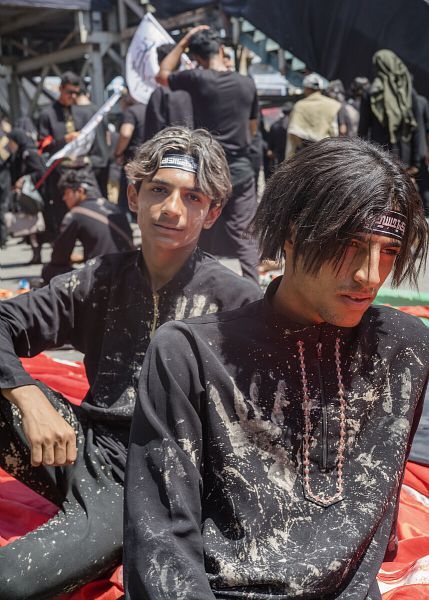
Arbaeen: a shared grief
Gabriel Gauffre / Le Pictorium
LePictorium_0283181.jpg
Among Shiite Muslims, Arbaeen commemorates the end of the mourning period for Imam Hussein, an important figure who died in 680 at the battle of Karbala, located in present-day Iraq. As one of the most important dates for this community, Shiites from all over the world come to pay their respects at the mausoleum erected on the site of his death. In 2023, 20 million pilgrims, mainly from Iran, but also from Afghanistan and Pakistan, made the journey to this holy city two hours' drive south of Baghdad. Largely repressed under Saddam Hussein, this pilgrimage has grown to become the largest gathering of human beings in the world.
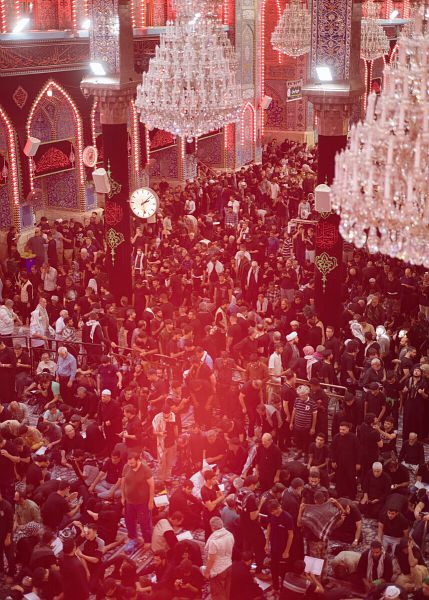
Arbaeen: a shared grief
Gabriel Gauffre / Le Pictorium
LePictorium_0283182.jpg
Worshippers inside the Shrine of Imam Hussein.
Among Shiite Muslims, Arbaeen commemorates the end of the mourning period for Imam Hussein, an important figure who died in 680 at the battle of Karbala, located in present-day Iraq. As one of the most important dates for this community, Shiites from all over the world come to pay their respects at the mausoleum erected on the site of his death. In 2023, 20 million pilgrims, mainly from Iran, but also from Afghanistan and Pakistan, made the journey to this holy city two hours' drive south of Baghdad. Largely repressed under Saddam Hussein, this pilgrimage has grown to become the largest gathering of human beings in the world.
Among Shiite Muslims, Arbaeen commemorates the end of the mourning period for Imam Hussein, an important figure who died in 680 at the battle of Karbala, located in present-day Iraq. As one of the most important dates for this community, Shiites from all over the world come to pay their respects at the mausoleum erected on the site of his death. In 2023, 20 million pilgrims, mainly from Iran, but also from Afghanistan and Pakistan, made the journey to this holy city two hours' drive south of Baghdad. Largely repressed under Saddam Hussein, this pilgrimage has grown to become the largest gathering of human beings in the world.
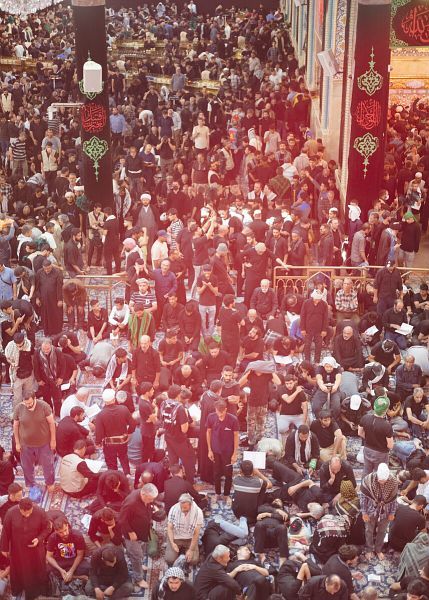
Arbaeen: a shared grief
Gabriel Gauffre / Le Pictorium
LePictorium_0283183.jpg
Worshippers inside the Shrine of Imam Hussein.
Among Shiite Muslims, Arbaeen commemorates the end of the mourning period for Imam Hussein, an important figure who died in 680 at the battle of Karbala, located in present-day Iraq. As one of the most important dates for this community, Shiites from all over the world come to pay their respects at the mausoleum erected on the site of his death. In 2023, 20 million pilgrims, mainly from Iran, but also from Afghanistan and Pakistan, made the journey to this holy city two hours' drive south of Baghdad. Largely repressed under Saddam Hussein, this pilgrimage has grown to become the largest gathering of human beings in the world.
Among Shiite Muslims, Arbaeen commemorates the end of the mourning period for Imam Hussein, an important figure who died in 680 at the battle of Karbala, located in present-day Iraq. As one of the most important dates for this community, Shiites from all over the world come to pay their respects at the mausoleum erected on the site of his death. In 2023, 20 million pilgrims, mainly from Iran, but also from Afghanistan and Pakistan, made the journey to this holy city two hours' drive south of Baghdad. Largely repressed under Saddam Hussein, this pilgrimage has grown to become the largest gathering of human beings in the world.
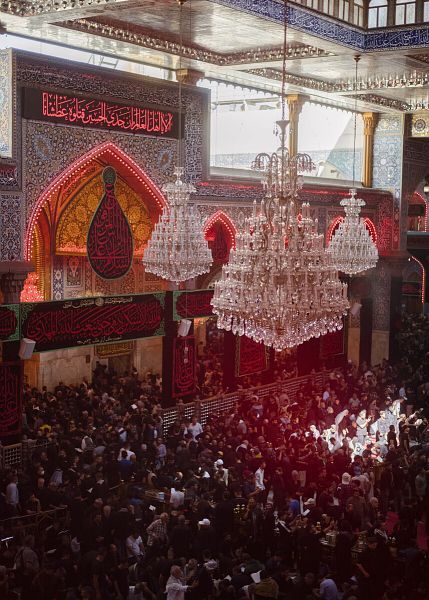
Arbaeen: a shared grief
Gabriel Gauffre / Le Pictorium
LePictorium_0283184.jpg
Worshippers inside the Shrine of Imam Hussein.
Among Shiite Muslims, Arbaeen commemorates the end of the mourning period for Imam Hussein, an important figure who died in 680 at the battle of Karbala, located in present-day Iraq. As one of the most important dates for this community, Shiites from all over the world come to pay their respects at the mausoleum erected on the site of his death. In 2023, 20 million pilgrims, mainly from Iran, but also from Afghanistan and Pakistan, made the journey to this holy city two hours' drive south of Baghdad. Largely repressed under Saddam Hussein, this pilgrimage has grown to become the largest gathering of human beings in the world.
Among Shiite Muslims, Arbaeen commemorates the end of the mourning period for Imam Hussein, an important figure who died in 680 at the battle of Karbala, located in present-day Iraq. As one of the most important dates for this community, Shiites from all over the world come to pay their respects at the mausoleum erected on the site of his death. In 2023, 20 million pilgrims, mainly from Iran, but also from Afghanistan and Pakistan, made the journey to this holy city two hours' drive south of Baghdad. Largely repressed under Saddam Hussein, this pilgrimage has grown to become the largest gathering of human beings in the world.
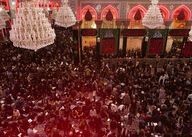
Arbaeen: a shared grief
Gabriel Gauffre / Le Pictorium
LePictorium_0283185.jpg
Worshippers inside the Shrine of Imam Hussein.
Among Shiite Muslims, Arbaeen commemorates the end of the mourning period for Imam Hussein, an important figure who died in 680 at the battle of Karbala, located in present-day Iraq. As one of the most important dates for this community, Shiites from all over the world come to pay their respects at the mausoleum erected on the site of his death. In 2023, 20 million pilgrims, mainly from Iran, but also from Afghanistan and Pakistan, made the journey to this holy city two hours' drive south of Baghdad. Largely repressed under Saddam Hussein, this pilgrimage has grown to become the largest gathering of human beings in the world.
Among Shiite Muslims, Arbaeen commemorates the end of the mourning period for Imam Hussein, an important figure who died in 680 at the battle of Karbala, located in present-day Iraq. As one of the most important dates for this community, Shiites from all over the world come to pay their respects at the mausoleum erected on the site of his death. In 2023, 20 million pilgrims, mainly from Iran, but also from Afghanistan and Pakistan, made the journey to this holy city two hours' drive south of Baghdad. Largely repressed under Saddam Hussein, this pilgrimage has grown to become the largest gathering of human beings in the world.

Arbaeen: a shared grief
Gabriel Gauffre / Le Pictorium
LePictorium_0283186.jpg
Worshippers inside the Shrine of Imam Hussein.
Among Shiite Muslims, Arbaeen commemorates the end of the mourning period for Imam Hussein, an important figure who died in 680 at the battle of Karbala, located in present-day Iraq. As one of the most important dates for this community, Shiites from all over the world come to pay their respects at the mausoleum erected on the site of his death. In 2023, 20 million pilgrims, mainly from Iran, but also from Afghanistan and Pakistan, made the journey to this holy city two hours' drive south of Baghdad. Largely repressed under Saddam Hussein, this pilgrimage has grown to become the largest gathering of human beings in the world.
Among Shiite Muslims, Arbaeen commemorates the end of the mourning period for Imam Hussein, an important figure who died in 680 at the battle of Karbala, located in present-day Iraq. As one of the most important dates for this community, Shiites from all over the world come to pay their respects at the mausoleum erected on the site of his death. In 2023, 20 million pilgrims, mainly from Iran, but also from Afghanistan and Pakistan, made the journey to this holy city two hours' drive south of Baghdad. Largely repressed under Saddam Hussein, this pilgrimage has grown to become the largest gathering of human beings in the world.
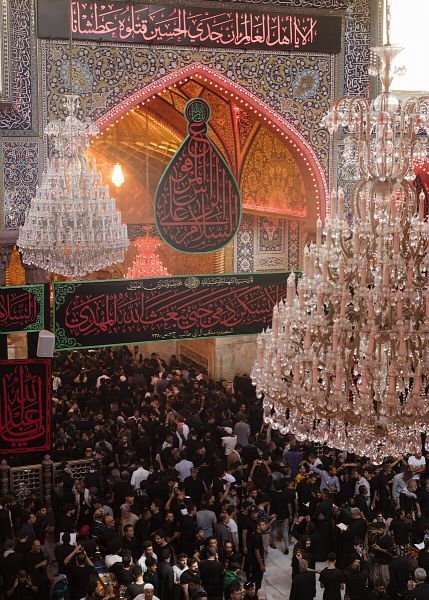
Arbaeen: a shared grief
Gabriel Gauffre / Le Pictorium
LePictorium_0283187.jpg
Worshippers inside the Shrine of Imam Hussein.
Among Shiite Muslims, Arbaeen commemorates the end of the mourning period for Imam Hussein, an important figure who died in 680 at the battle of Karbala, located in present-day Iraq. As one of the most important dates for this community, Shiites from all over the world come to pay their respects at the mausoleum erected on the site of his death. In 2023, 20 million pilgrims, mainly from Iran, but also from Afghanistan and Pakistan, made the journey to this holy city two hours' drive south of Baghdad. Largely repressed under Saddam Hussein, this pilgrimage has grown to become the largest gathering of human beings in the world.
Among Shiite Muslims, Arbaeen commemorates the end of the mourning period for Imam Hussein, an important figure who died in 680 at the battle of Karbala, located in present-day Iraq. As one of the most important dates for this community, Shiites from all over the world come to pay their respects at the mausoleum erected on the site of his death. In 2023, 20 million pilgrims, mainly from Iran, but also from Afghanistan and Pakistan, made the journey to this holy city two hours' drive south of Baghdad. Largely repressed under Saddam Hussein, this pilgrimage has grown to become the largest gathering of human beings in the world.

Arbaeen: a shared grief
Gabriel Gauffre / Le Pictorium
LePictorium_0283188.jpg
Worshippers inside the Shrine of Imam Hussein.
Among Shiite Muslims, Arbaeen commemorates the end of the mourning period for Imam Hussein, an important figure who died in 680 at the battle of Karbala, located in present-day Iraq. As one of the most important dates for this community, Shiites from all over the world come to pay their respects at the mausoleum erected on the site of his death. In 2023, 20 million pilgrims, mainly from Iran, but also from Afghanistan and Pakistan, made the journey to this holy city two hours' drive south of Baghdad. Largely repressed under Saddam Hussein, this pilgrimage has grown to become the largest gathering of human beings in the world.
Among Shiite Muslims, Arbaeen commemorates the end of the mourning period for Imam Hussein, an important figure who died in 680 at the battle of Karbala, located in present-day Iraq. As one of the most important dates for this community, Shiites from all over the world come to pay their respects at the mausoleum erected on the site of his death. In 2023, 20 million pilgrims, mainly from Iran, but also from Afghanistan and Pakistan, made the journey to this holy city two hours' drive south of Baghdad. Largely repressed under Saddam Hussein, this pilgrimage has grown to become the largest gathering of human beings in the world.
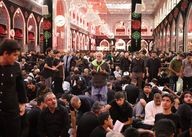
Arbaeen: a shared grief
Gabriel Gauffre / Le Pictorium
LePictorium_0283189.jpg
Worshippers inside the Shrine of Imam Hussein.
Among Shiite Muslims, Arbaeen commemorates the end of the mourning period for Imam Hussein, an important figure who died in 680 at the battle of Karbala, located in present-day Iraq. As one of the most important dates for this community, Shiites from all over the world come to pay their respects at the mausoleum erected on the site of his death. In 2023, 20 million pilgrims, mainly from Iran, but also from Afghanistan and Pakistan, made the journey to this holy city two hours' drive south of Baghdad. Largely repressed under Saddam Hussein, this pilgrimage has grown to become the largest gathering of human beings in the world.
Among Shiite Muslims, Arbaeen commemorates the end of the mourning period for Imam Hussein, an important figure who died in 680 at the battle of Karbala, located in present-day Iraq. As one of the most important dates for this community, Shiites from all over the world come to pay their respects at the mausoleum erected on the site of his death. In 2023, 20 million pilgrims, mainly from Iran, but also from Afghanistan and Pakistan, made the journey to this holy city two hours' drive south of Baghdad. Largely repressed under Saddam Hussein, this pilgrimage has grown to become the largest gathering of human beings in the world.
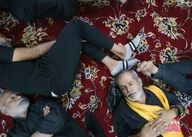
Arbaeen: a shared grief
Gabriel Gauffre / Le Pictorium
LePictorium_0283190.jpg
Worshippers rest inside the shrine of Imam Hussein.
Among Shiite Muslims, Arbaeen commemorates the end of the mourning period for Imam Hussein, an important figure who died in 680 at the battle of Karbala, located in present-day Iraq. As one of the most important dates for this community, Shiites from all over the world come to pay their respects at the mausoleum erected on the site of his death. In 2023, 20 million pilgrims, mainly from Iran, but also from Afghanistan and Pakistan, made the journey to this holy city two hours' drive south of Baghdad. Largely repressed under Saddam Hussein, this pilgrimage has grown to become the largest gathering of human beings in the world.
Among Shiite Muslims, Arbaeen commemorates the end of the mourning period for Imam Hussein, an important figure who died in 680 at the battle of Karbala, located in present-day Iraq. As one of the most important dates for this community, Shiites from all over the world come to pay their respects at the mausoleum erected on the site of his death. In 2023, 20 million pilgrims, mainly from Iran, but also from Afghanistan and Pakistan, made the journey to this holy city two hours' drive south of Baghdad. Largely repressed under Saddam Hussein, this pilgrimage has grown to become the largest gathering of human beings in the world.

Arbaeen: a shared grief
Gabriel Gauffre / Le Pictorium
LePictorium_0283191.jpg
Worshippers rest inside the shrine of Imam Hussein.
Among Shiite Muslims, Arbaeen commemorates the end of the mourning period for Imam Hussein, an important figure who died in 680 at the battle of Karbala, located in present-day Iraq. As one of the most important dates for this community, Shiites from all over the world come to pay their respects at the mausoleum erected on the site of his death. In 2023, 20 million pilgrims, mainly from Iran, but also from Afghanistan and Pakistan, made the journey to this holy city two hours' drive south of Baghdad. Largely repressed under Saddam Hussein, this pilgrimage has grown to become the largest gathering of human beings in the world.
Among Shiite Muslims, Arbaeen commemorates the end of the mourning period for Imam Hussein, an important figure who died in 680 at the battle of Karbala, located in present-day Iraq. As one of the most important dates for this community, Shiites from all over the world come to pay their respects at the mausoleum erected on the site of his death. In 2023, 20 million pilgrims, mainly from Iran, but also from Afghanistan and Pakistan, made the journey to this holy city two hours' drive south of Baghdad. Largely repressed under Saddam Hussein, this pilgrimage has grown to become the largest gathering of human beings in the world.
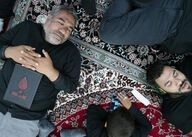
Arbaeen: a shared grief
Gabriel Gauffre / Le Pictorium
LePictorium_0283192.jpg
Worshippers rest inside the shrine of Imam Hussein.
Among Shiite Muslims, Arbaeen commemorates the end of the mourning period for Imam Hussein, an important figure who died in 680 at the battle of Karbala, located in present-day Iraq. As one of the most important dates for this community, Shiites from all over the world come to pay their respects at the mausoleum erected on the site of his death. In 2023, 20 million pilgrims, mainly from Iran, but also from Afghanistan and Pakistan, made the journey to this holy city two hours' drive south of Baghdad. Largely repressed under Saddam Hussein, this pilgrimage has grown to become the largest gathering of human beings in the world.
Among Shiite Muslims, Arbaeen commemorates the end of the mourning period for Imam Hussein, an important figure who died in 680 at the battle of Karbala, located in present-day Iraq. As one of the most important dates for this community, Shiites from all over the world come to pay their respects at the mausoleum erected on the site of his death. In 2023, 20 million pilgrims, mainly from Iran, but also from Afghanistan and Pakistan, made the journey to this holy city two hours' drive south of Baghdad. Largely repressed under Saddam Hussein, this pilgrimage has grown to become the largest gathering of human beings in the world.

Arbaeen: a shared grief
Gabriel Gauffre / Le Pictorium
LePictorium_0283193.jpg
Worshippers rest inside the shrine of Imam Hussein.
Among Shiite Muslims, Arbaeen commemorates the end of the mourning period for Imam Hussein, an important figure who died in 680 at the battle of Karbala, located in present-day Iraq. As one of the most important dates for this community, Shiites from all over the world come to pay their respects at the mausoleum erected on the site of his death. In 2023, 20 million pilgrims, mainly from Iran, but also from Afghanistan and Pakistan, made the journey to this holy city two hours' drive south of Baghdad. Largely repressed under Saddam Hussein, this pilgrimage has grown to become the largest gathering of human beings in the world.
Among Shiite Muslims, Arbaeen commemorates the end of the mourning period for Imam Hussein, an important figure who died in 680 at the battle of Karbala, located in present-day Iraq. As one of the most important dates for this community, Shiites from all over the world come to pay their respects at the mausoleum erected on the site of his death. In 2023, 20 million pilgrims, mainly from Iran, but also from Afghanistan and Pakistan, made the journey to this holy city two hours' drive south of Baghdad. Largely repressed under Saddam Hussein, this pilgrimage has grown to become the largest gathering of human beings in the world.
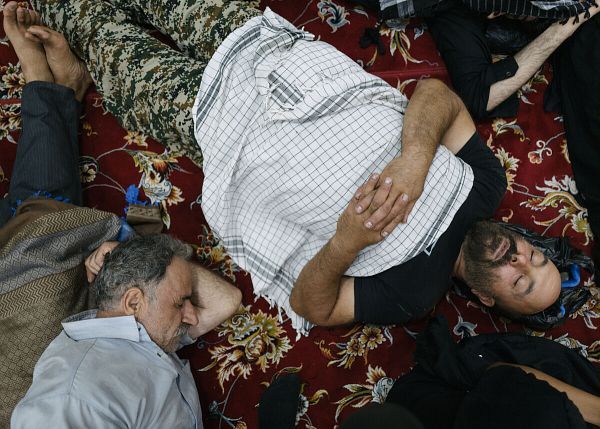
Arbaeen: a shared grief
Gabriel Gauffre / Le Pictorium
LePictorium_0283194.jpg
Worshippers rest inside the shrine of Imam Hussein.
Among Shiite Muslims, Arbaeen commemorates the end of the mourning period for Imam Hussein, an important figure who died in 680 at the battle of Karbala, located in present-day Iraq. As one of the most important dates for this community, Shiites from all over the world come to pay their respects at the mausoleum erected on the site of his death. In 2023, 20 million pilgrims, mainly from Iran, but also from Afghanistan and Pakistan, made the journey to this holy city two hours' drive south of Baghdad. Largely repressed under Saddam Hussein, this pilgrimage has grown to become the largest gathering of human beings in the world.
Among Shiite Muslims, Arbaeen commemorates the end of the mourning period for Imam Hussein, an important figure who died in 680 at the battle of Karbala, located in present-day Iraq. As one of the most important dates for this community, Shiites from all over the world come to pay their respects at the mausoleum erected on the site of his death. In 2023, 20 million pilgrims, mainly from Iran, but also from Afghanistan and Pakistan, made the journey to this holy city two hours' drive south of Baghdad. Largely repressed under Saddam Hussein, this pilgrimage has grown to become the largest gathering of human beings in the world.

Arbaeen: a shared grief
Gabriel Gauffre / Le Pictorium
LePictorium_0283195.jpg
Worshippers rest inside the shrine of Imam Hussein.
Among Shiite Muslims, Arbaeen commemorates the end of the mourning period for Imam Hussein, an important figure who died in 680 at the battle of Karbala, located in present-day Iraq. As one of the most important dates for this community, Shiites from all over the world come to pay their respects at the mausoleum erected on the site of his death. In 2023, 20 million pilgrims, mainly from Iran, but also from Afghanistan and Pakistan, made the journey to this holy city two hours' drive south of Baghdad. Largely repressed under Saddam Hussein, this pilgrimage has grown to become the largest gathering of human beings in the world.
Among Shiite Muslims, Arbaeen commemorates the end of the mourning period for Imam Hussein, an important figure who died in 680 at the battle of Karbala, located in present-day Iraq. As one of the most important dates for this community, Shiites from all over the world come to pay their respects at the mausoleum erected on the site of his death. In 2023, 20 million pilgrims, mainly from Iran, but also from Afghanistan and Pakistan, made the journey to this holy city two hours' drive south of Baghdad. Largely repressed under Saddam Hussein, this pilgrimage has grown to become the largest gathering of human beings in the world.

Arbaeen: a shared grief
Gabriel Gauffre / Le Pictorium
LePictorium_0283196.jpg
Worshippers rest inside the shrine of Imam Hussein.
Among Shiite Muslims, Arbaeen commemorates the end of the mourning period for Imam Hussein, an important figure who died in 680 at the battle of Karbala, located in present-day Iraq. As one of the most important dates for this community, Shiites from all over the world come to pay their respects at the mausoleum erected on the site of his death. In 2023, 20 million pilgrims, mainly from Iran, but also from Afghanistan and Pakistan, made the journey to this holy city two hours' drive south of Baghdad. Largely repressed under Saddam Hussein, this pilgrimage has grown to become the largest gathering of human beings in the world.
Among Shiite Muslims, Arbaeen commemorates the end of the mourning period for Imam Hussein, an important figure who died in 680 at the battle of Karbala, located in present-day Iraq. As one of the most important dates for this community, Shiites from all over the world come to pay their respects at the mausoleum erected on the site of his death. In 2023, 20 million pilgrims, mainly from Iran, but also from Afghanistan and Pakistan, made the journey to this holy city two hours' drive south of Baghdad. Largely repressed under Saddam Hussein, this pilgrimage has grown to become the largest gathering of human beings in the world.
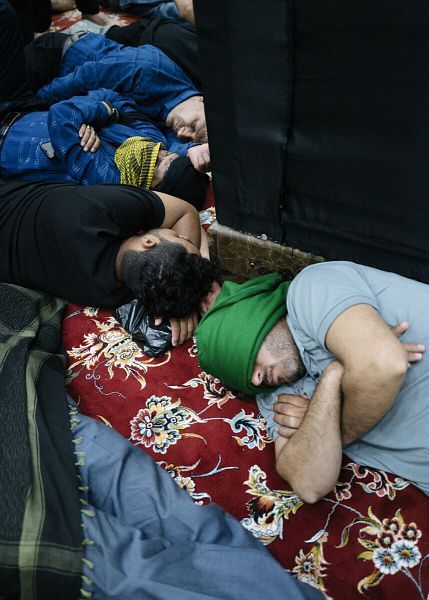
Arbaeen: a shared grief
Gabriel Gauffre / Le Pictorium
LePictorium_0283197.jpg
Worshippers rest inside the shrine of Imam Hussein.
Among Shiite Muslims, Arbaeen commemorates the end of the mourning period for Imam Hussein, an important figure who died in 680 at the battle of Karbala, located in present-day Iraq. As one of the most important dates for this community, Shiites from all over the world come to pay their respects at the mausoleum erected on the site of his death. In 2023, 20 million pilgrims, mainly from Iran, but also from Afghanistan and Pakistan, made the journey to this holy city two hours' drive south of Baghdad. Largely repressed under Saddam Hussein, this pilgrimage has grown to become the largest gathering of human beings in the world.
Among Shiite Muslims, Arbaeen commemorates the end of the mourning period for Imam Hussein, an important figure who died in 680 at the battle of Karbala, located in present-day Iraq. As one of the most important dates for this community, Shiites from all over the world come to pay their respects at the mausoleum erected on the site of his death. In 2023, 20 million pilgrims, mainly from Iran, but also from Afghanistan and Pakistan, made the journey to this holy city two hours' drive south of Baghdad. Largely repressed under Saddam Hussein, this pilgrimage has grown to become the largest gathering of human beings in the world.

Arbaeen: a shared grief
Gabriel Gauffre / Le Pictorium
LePictorium_0283198.jpg
Worshippers rest inside the shrine of Imam Hussein.
Among Shiite Muslims, Arbaeen commemorates the end of the mourning period for Imam Hussein, an important figure who died in 680 at the battle of Karbala, located in present-day Iraq. As one of the most important dates for this community, Shiites from all over the world come to pay their respects at the mausoleum erected on the site of his death. In 2023, 20 million pilgrims, mainly from Iran, but also from Afghanistan and Pakistan, made the journey to this holy city two hours' drive south of Baghdad. Largely repressed under Saddam Hussein, this pilgrimage has grown to become the largest gathering of human beings in the world.
Among Shiite Muslims, Arbaeen commemorates the end of the mourning period for Imam Hussein, an important figure who died in 680 at the battle of Karbala, located in present-day Iraq. As one of the most important dates for this community, Shiites from all over the world come to pay their respects at the mausoleum erected on the site of his death. In 2023, 20 million pilgrims, mainly from Iran, but also from Afghanistan and Pakistan, made the journey to this holy city two hours' drive south of Baghdad. Largely repressed under Saddam Hussein, this pilgrimage has grown to become the largest gathering of human beings in the world.
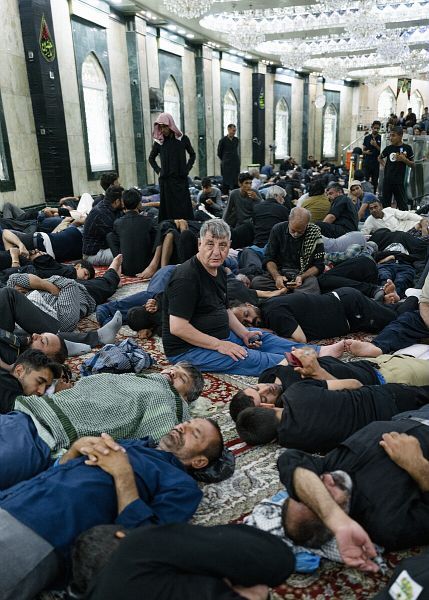
Arbaeen: a shared grief
Gabriel Gauffre / Le Pictorium
LePictorium_0283199.jpg
Worshippers rest inside the shrine of Imam Hussein.
Among Shiite Muslims, Arbaeen commemorates the end of the mourning period for Imam Hussein, an important figure who died in 680 at the battle of Karbala, located in present-day Iraq. As one of the most important dates for this community, Shiites from all over the world come to pay their respects at the mausoleum erected on the site of his death. In 2023, 20 million pilgrims, mainly from Iran, but also from Afghanistan and Pakistan, made the journey to this holy city two hours' drive south of Baghdad. Largely repressed under Saddam Hussein, this pilgrimage has grown to become the largest gathering of human beings in the world.
Among Shiite Muslims, Arbaeen commemorates the end of the mourning period for Imam Hussein, an important figure who died in 680 at the battle of Karbala, located in present-day Iraq. As one of the most important dates for this community, Shiites from all over the world come to pay their respects at the mausoleum erected on the site of his death. In 2023, 20 million pilgrims, mainly from Iran, but also from Afghanistan and Pakistan, made the journey to this holy city two hours' drive south of Baghdad. Largely repressed under Saddam Hussein, this pilgrimage has grown to become the largest gathering of human beings in the world.

Arbaeen: a shared grief
Gabriel Gauffre / Le Pictorium
LePictorium_0283200.jpg
Worshippers inside the Shrine of Imam Hussein.
Among Shiite Muslims, Arbaeen commemorates the end of the mourning period for Imam Hussein, an important figure who died in 680 at the battle of Karbala, located in present-day Iraq. As one of the most important dates for this community, Shiites from all over the world come to pay their respects at the mausoleum erected on the site of his death. In 2023, 20 million pilgrims, mainly from Iran, but also from Afghanistan and Pakistan, made the journey to this holy city two hours' drive south of Baghdad. Largely repressed under Saddam Hussein, this pilgrimage has grown to become the largest gathering of human beings in the world.
Among Shiite Muslims, Arbaeen commemorates the end of the mourning period for Imam Hussein, an important figure who died in 680 at the battle of Karbala, located in present-day Iraq. As one of the most important dates for this community, Shiites from all over the world come to pay their respects at the mausoleum erected on the site of his death. In 2023, 20 million pilgrims, mainly from Iran, but also from Afghanistan and Pakistan, made the journey to this holy city two hours' drive south of Baghdad. Largely repressed under Saddam Hussein, this pilgrimage has grown to become the largest gathering of human beings in the world.
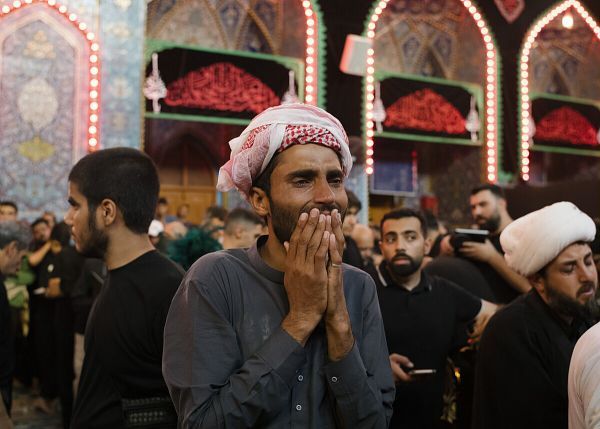
Arbaeen: a shared grief
Gabriel Gauffre / Le Pictorium
LePictorium_0283201.jpg
Worshippers inside the Shrine of Imam Hussein.
Among Shiite Muslims, Arbaeen commemorates the end of the mourning period for Imam Hussein, an important figure who died in 680 at the battle of Karbala, located in present-day Iraq. As one of the most important dates for this community, Shiites from all over the world come to pay their respects at the mausoleum erected on the site of his death. In 2023, 20 million pilgrims, mainly from Iran, but also from Afghanistan and Pakistan, made the journey to this holy city two hours' drive south of Baghdad. Largely repressed under Saddam Hussein, this pilgrimage has grown to become the largest gathering of human beings in the world.
Among Shiite Muslims, Arbaeen commemorates the end of the mourning period for Imam Hussein, an important figure who died in 680 at the battle of Karbala, located in present-day Iraq. As one of the most important dates for this community, Shiites from all over the world come to pay their respects at the mausoleum erected on the site of his death. In 2023, 20 million pilgrims, mainly from Iran, but also from Afghanistan and Pakistan, made the journey to this holy city two hours' drive south of Baghdad. Largely repressed under Saddam Hussein, this pilgrimage has grown to become the largest gathering of human beings in the world.
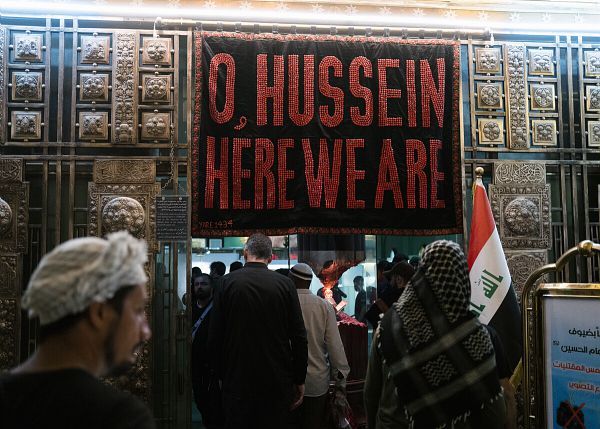
Arbaeen: a shared grief
Gabriel Gauffre / Le Pictorium
LePictorium_0283202.jpg
Worshippers inside the Shrine of Imam Hussein.
Among Shiite Muslims, Arbaeen commemorates the end of the mourning period for Imam Hussein, an important figure who died in 680 at the battle of Karbala, located in present-day Iraq. As one of the most important dates for this community, Shiites from all over the world come to pay their respects at the mausoleum erected on the site of his death. In 2023, 20 million pilgrims, mainly from Iran, but also from Afghanistan and Pakistan, made the journey to this holy city two hours' drive south of Baghdad. Largely repressed under Saddam Hussein, this pilgrimage has grown to become the largest gathering of human beings in the world.
Among Shiite Muslims, Arbaeen commemorates the end of the mourning period for Imam Hussein, an important figure who died in 680 at the battle of Karbala, located in present-day Iraq. As one of the most important dates for this community, Shiites from all over the world come to pay their respects at the mausoleum erected on the site of his death. In 2023, 20 million pilgrims, mainly from Iran, but also from Afghanistan and Pakistan, made the journey to this holy city two hours' drive south of Baghdad. Largely repressed under Saddam Hussein, this pilgrimage has grown to become the largest gathering of human beings in the world.
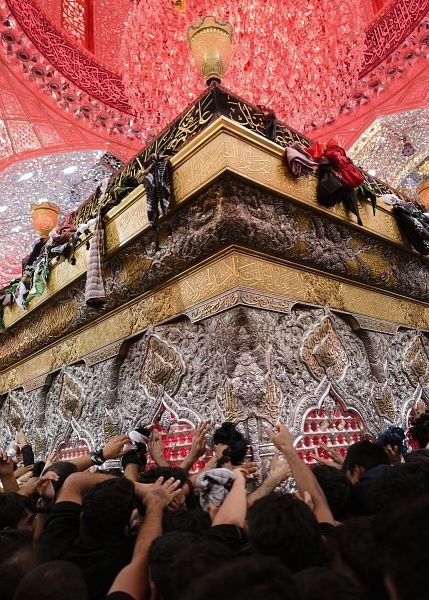
Arbaeen: a shared grief
Gabriel Gauffre / Le Pictorium
LePictorium_0283203.jpg
Worshippers try to touch the tomb of Imam Hussein, at the heart of the sanctuary.
Among Shiite Muslims, Arbaeen commemorates the end of the mourning period for Imam Hussein, an important figure who died in 680 at the battle of Karbala, located in present-day Iraq. As one of the most important dates for this community, Shiites from all over the world come to pay their respects at the mausoleum erected on the site of his death. In 2023, 20 million pilgrims, mainly from Iran, but also from Afghanistan and Pakistan, made the journey to this holy city two hours' drive south of Baghdad. Largely repressed under Saddam Hussein, this pilgrimage has grown to become the largest gathering of human beings in the world.
Among Shiite Muslims, Arbaeen commemorates the end of the mourning period for Imam Hussein, an important figure who died in 680 at the battle of Karbala, located in present-day Iraq. As one of the most important dates for this community, Shiites from all over the world come to pay their respects at the mausoleum erected on the site of his death. In 2023, 20 million pilgrims, mainly from Iran, but also from Afghanistan and Pakistan, made the journey to this holy city two hours' drive south of Baghdad. Largely repressed under Saddam Hussein, this pilgrimage has grown to become the largest gathering of human beings in the world.
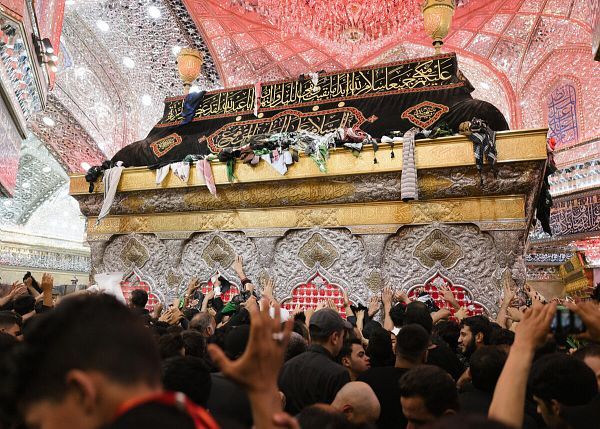
Arbaeen: a shared grief
Gabriel Gauffre / Le Pictorium
LePictorium_0283204.jpg
Worshippers try to touch the tomb of Imam Hussein, at the heart of the sanctuary.
Among Shiite Muslims, Arbaeen commemorates the end of the mourning period for Imam Hussein, an important figure who died in 680 at the battle of Karbala, located in present-day Iraq. As one of the most important dates for this community, Shiites from all over the world come to pay their respects at the mausoleum erected on the site of his death. In 2023, 20 million pilgrims, mainly from Iran, but also from Afghanistan and Pakistan, made the journey to this holy city two hours' drive south of Baghdad. Largely repressed under Saddam Hussein, this pilgrimage has grown to become the largest gathering of human beings in the world.
Among Shiite Muslims, Arbaeen commemorates the end of the mourning period for Imam Hussein, an important figure who died in 680 at the battle of Karbala, located in present-day Iraq. As one of the most important dates for this community, Shiites from all over the world come to pay their respects at the mausoleum erected on the site of his death. In 2023, 20 million pilgrims, mainly from Iran, but also from Afghanistan and Pakistan, made the journey to this holy city two hours' drive south of Baghdad. Largely repressed under Saddam Hussein, this pilgrimage has grown to become the largest gathering of human beings in the world.

Arbaeen: a shared grief
Gabriel Gauffre / Le Pictorium
LePictorium_0283205.jpg
A camel is prepared for slaughter to feed pilgrims in Karbala.
Among Shiite Muslims, Arbaeen commemorates the end of the mourning period for Imam Hussein, an important figure who died in 680 at the battle of Karbala, located in present-day Iraq. As one of the most important dates for this community, Shiites from all over the world come to pay their respects at the mausoleum erected on the site of his death. In 2023, 20 million pilgrims, mainly from Iran, but also from Afghanistan and Pakistan, made the journey to this holy city two hours' drive south of Baghdad. Largely repressed under Saddam Hussein, this pilgrimage has grown to become the largest gathering of human beings in the world.
Among Shiite Muslims, Arbaeen commemorates the end of the mourning period for Imam Hussein, an important figure who died in 680 at the battle of Karbala, located in present-day Iraq. As one of the most important dates for this community, Shiites from all over the world come to pay their respects at the mausoleum erected on the site of his death. In 2023, 20 million pilgrims, mainly from Iran, but also from Afghanistan and Pakistan, made the journey to this holy city two hours' drive south of Baghdad. Largely repressed under Saddam Hussein, this pilgrimage has grown to become the largest gathering of human beings in the world.
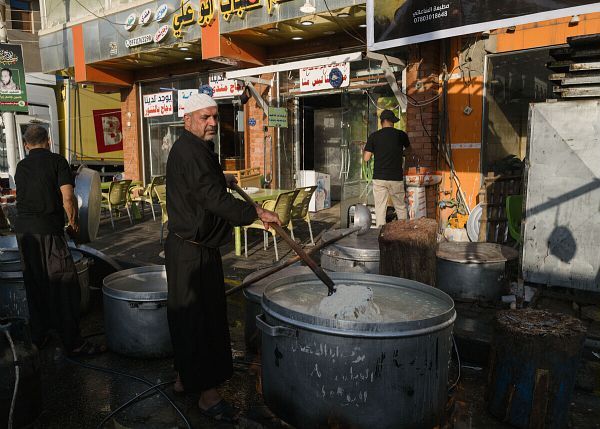
Arbaeen: a shared grief
Gabriel Gauffre / Le Pictorium
LePictorium_0283206.jpg
A man prepares rice to feed pilgrims in Kerbala.
Among Shiite Muslims, Arbaeen commemorates the end of the mourning period for Imam Hussein, an important figure who died in 680 at the battle of Karbala, located in present-day Iraq. As one of the most important dates for this community, Shiites from all over the world come to pay their respects at the mausoleum erected on the site of his death. In 2023, 20 million pilgrims, mainly from Iran, but also from Afghanistan and Pakistan, made the journey to this holy city two hours' drive south of Baghdad. Largely repressed under Saddam Hussein, this pilgrimage has grown to become the largest gathering of human beings in the world.
Among Shiite Muslims, Arbaeen commemorates the end of the mourning period for Imam Hussein, an important figure who died in 680 at the battle of Karbala, located in present-day Iraq. As one of the most important dates for this community, Shiites from all over the world come to pay their respects at the mausoleum erected on the site of his death. In 2023, 20 million pilgrims, mainly from Iran, but also from Afghanistan and Pakistan, made the journey to this holy city two hours' drive south of Baghdad. Largely repressed under Saddam Hussein, this pilgrimage has grown to become the largest gathering of human beings in the world.

Arbaeen: a shared grief
Gabriel Gauffre / Le Pictorium
LePictorium_0283207.jpg
A child distributes drinks to pilgrims.
Among Shiite Muslims, Arbaeen commemorates the end of the mourning period for Imam Hussein, an important figure who died in 680 at the battle of Karbala, located in present-day Iraq. As one of the most important dates for this community, Shiites from all over the world come to pay their respects at the mausoleum erected on the site of his death. In 2023, 20 million pilgrims, mainly from Iran, but also from Afghanistan and Pakistan, made the journey to this holy city two hours' drive south of Baghdad. Largely repressed under Saddam Hussein, this pilgrimage has grown to become the largest gathering of human beings in the world.
Among Shiite Muslims, Arbaeen commemorates the end of the mourning period for Imam Hussein, an important figure who died in 680 at the battle of Karbala, located in present-day Iraq. As one of the most important dates for this community, Shiites from all over the world come to pay their respects at the mausoleum erected on the site of his death. In 2023, 20 million pilgrims, mainly from Iran, but also from Afghanistan and Pakistan, made the journey to this holy city two hours' drive south of Baghdad. Largely repressed under Saddam Hussein, this pilgrimage has grown to become the largest gathering of human beings in the world.
Next page
